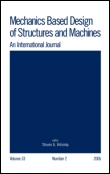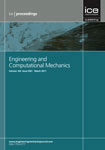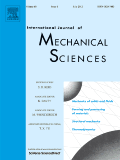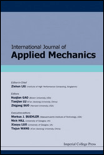
MECHANICS BASED DESIGN OF STRUCTURES AND MACHINES
Scope & Guideline
Exploring New Frontiers in Structural Design
Introduction
Aims and Scopes
- Mechanics of Materials:
Research on the behavior of materials under various loading conditions, including stress, strain, and deformation, particularly in functionally graded and composite materials. - Structural Analysis and Design:
Focus on the analysis and optimization of structures, including buckling, vibration, and stability assessments, often utilizing advanced computational techniques. - Dynamic Systems and Control:
Investigations into the dynamic behavior of mechanical systems, including vibration control, energy harvesting, and system stability. - Computational Mechanics:
Utilization of numerical methods such as finite element analysis (FEA) and meshless methods for solving complex mechanical problems. - Innovative Materials and Structures:
Research on new materials, such as nanocomposites and metamaterials, and their applications in structural designs to enhance performance. - Multiscale Modeling:
Studies that bridge different scales of analysis, from nano to macro, to understand the mechanical properties and behaviors of materials and structures. - Thermoelastic and Coupled Field Problems:
Research addressing the interaction of thermal, mechanical, and electrical fields in materials and structures, particularly under dynamic conditions.
Trending and Emerging
- Functionally Graded Materials (FGMs):
A growing body of research on the design and analysis of functionally graded materials, which offer tailored properties for specific applications, is evident. This includes their application in aerospace, automotive, and civil engineering. - Advanced Computational Techniques:
There is an increasing trend in the use of advanced computational methods, including machine learning and AI, to optimize designs and predict performance in complex systems. - Dynamic and Nonlinear Analysis:
Research focusing on the dynamic and nonlinear behavior of structures and materials is trending, reflecting the need for more accurate simulations of real-world conditions. - Smart Materials and Structures:
The exploration of smart materials that respond to environmental stimuli, along with their applications in advanced engineering systems, is emerging as a key area of interest. - Sustainability and Eco-friendly Design:
There is a noticeable increase in studies addressing sustainability in mechanical design, including the use of recyclable materials and energy-efficient design practices. - Multi-Physics and Coupled Field Problems:
Research involving multi-physics interactions, particularly thermo-mechanical and electro-mechanical coupling, is gaining momentum, indicating a shift towards more holistic design approaches.
Declining or Waning
- Traditional Static Analysis Methods:
There has been a noticeable decline in papers focusing solely on traditional static analysis methods, as newer dynamic and computational approaches gain traction. - Basic Material Characterization:
Research that is primarily concerned with basic material characterization without application to design or structures is less frequently published, indicating a shift towards more applied studies. - Empirical Testing without Modeling:
Studies emphasizing empirical testing alone, without accompanying theoretical or computational modeling, are becoming less common, as the integration of modeling techniques is increasingly valued. - Conventional Mechanical Systems:
Research focused on conventional mechanical systems without innovative applications or modifications is waning, as the field moves towards more advanced and adaptive systems.
Similar Journals

International Journal of Structural Integrity
Championing High-Impact Research in Engineering DisciplinesInternational Journal of Structural Integrity is a premier peer-reviewed academic journal published by EMERALD GROUP PUBLISHING LTD in the United Kingdom. As a valuable resource in the fields of Civil and Structural Engineering, Mechanical Engineering, and Mechanics of Materials, this journal serves to advance knowledge and foster innovation in these critical areas of study. With an impressive impact factor reflected in its 2023 category quartiles, ranking Q2 across multiple engineering disciplines, the journal is recognized for its contributions to research and practical application. Researchers can benefit from its rigorous publishing standards that encompass a wide array of interdisciplinary topics pertaining to structural integrity. Accessing the journal is facilitated for those seeking high-quality research and findings, vital to both academia and industry. Since its inception in 2010 and extending until 2024, the journal continues to attract scholarly articles that push the boundaries of engineering knowledge, making it an essential platform for professionals, students, and researchers seeking to stay at the forefront of structural engineering."

Moscow University Mechanics Bulletin
Connecting Innovators in Mechanical ResearchMoscow University Mechanics Bulletin, published by PLEIADES PUBLISHING INC, is a dedicated journal that has been influencing the fields of mechanical engineering and mechanics since its inception. With an ISSN of 0027-1330 and E-ISSN of 1934-8452, this journal serves as a crucial platform for advancing knowledge in mathematics, mechanical engineering, and mechanics of materials. Though currently indexed in the Q4 category across these disciplines, it offers a unique space for researchers and professionals to engage with emerging theories, experimental results, and practical applications. With a converged publication history spanning from 1973 to 1987, and continuing from 2007 to 2024, the journal remains relevant in today’s academic landscape. Though it operates under traditional access models, the journal's global reach aims to connect diverse voices in engineering research. Aspiring researchers and seasoned professionals alike will find valuable insights and a robust discourse that contribute to their respective fields.

MECCANICA
Illuminating Pathways in Engineering ResearchMECCANICA, an esteemed journal published by Springer, stands at the forefront of research in the fields of Condensed Matter Physics, Mechanical Engineering, and Mechanics of Materials. Established in 1966 and continuing through 2024, this journal provides a robust platform for the dissemination of innovative research and advancements in these increasingly interconnected domains. With an impressive 2023 ranking placing it in the Q2 category across multiple fields, MECCANICA boasts a Scopus rank of #198 in Mechanical Engineering, #150 in Condensed Matter Physics, and #141 in Mechanics of Materials, highlighting its significance and influence within the scholarly community. The journal aims to foster dialogue among researchers, professionals, and students, facilitating the exchange of cutting-edge ideas and methodologies crucial for overcoming contemporary engineering and physics challenges. Readers can access a wealth of knowledge through its comprehensive articles, and while it does not currently offer open access, the journal remains instrumental in shaping the future of engineering and physical sciences.

APPLIED MATHEMATICS AND MECHANICS-ENGLISH EDITION
Driving Progress in Engineering through Mathematical RigorApplied Mathematics and Mechanics - English Edition is a prestigious journal published by Shanghai University, focusing on the interdisciplinary applications of mathematics and mechanics across various scientific and engineering domains. With an ISSN of 0253-4827 and an E-ISSN of 1573-2754, this journal has established itself as a vital resource since its inception in 1980, extending its coverage well into 2024. The journal boasts impressive Scopus rankings—placing it in the top 10% of the Applied Mathematics category and the top 20% in Mechanical Engineering and Mechanics of Materials—reflecting its significant impact and contribution to research. Currently categorized in the Q2 and Q1 quartiles, it caters to a diverse audience that includes researchers, professionals, and students seeking to explore cutting-edge developments and innovative methodologies in the field. Although the journal is not open access, it remains committed to disseminating high-quality research that addresses contemporary challenges in applied mathematics and mechanics, fostering a deeper understanding of their practical implications.

Proceedings of the Institution of Civil Engineers-Engineering and Computational Mechanics
Empowering Engineers with Cutting-Edge Research and ApplicationsProceedings of the Institution of Civil Engineers - Engineering and Computational Mechanics is a prestigious journal published by Emerald Group Publishing Ltd, dedicated to advancing the fields of civil and structural engineering, as well as mechanics of materials. With an ISSN of 1755-0777 and E-ISSN 1755-0785, this journal serves as a critical platform for disseminating innovative research and practical insights from 2009 through 2024. As part of its commitment to academic rigor, it is categorized in the Q4 quartile for both civil and structural engineering and mechanics of materials, reflecting a unique position in the scholarly community. The journal is essential for professionals, researchers, and students aiming to stay informed on current trends, methodologies, and applications in engineering and computational mechanics. By engaging with this publication, readers gain access to crucial findings that contribute to the advancement of infrastructure and materials science, vital for developing resilient and sustainable engineering solutions.

Coupled Systems Mechanics
Bridging Theory and Practice in Structural MechanicsCoupled Systems Mechanics is a pioneering journal in the fields of Civil and Structural Engineering and Mechanics of Materials, published by TECHNO-PRESS. With an ISSN of 2234-2184 and an E-ISSN of 2234-2192, this journal actively contributes to the academic discourse surrounding coupled system mechanics, addressing complex interactions within engineering disciplines. Hailing from South Korea, the journal has been committed to disseminating high-quality research since its inception, converging years from 2017 to 2024. It holds a respectable Q3 ranking in both Civil and Structural Engineering and Mechanics of Materials, indicating its relevance and impact within these fields. Researchers, professionals, and students can expect cutting-edge studies and innovative methodologies, as the journal consistently aims to enhance understanding and application of coupled systems in engineering. Although it operates under a subscription model, it remains an essential resource for those looking to stay at the forefront of advancements in engineering sciences.

INTERNATIONAL JOURNAL OF MECHANICAL SCIENCES
Advancing the Frontiers of Mechanical InnovationThe INTERNATIONAL JOURNAL OF MECHANICAL SCIENCES, published by PERGAMON-ELSEVIER SCIENCE LTD, stands as a premier platform for groundbreaking research in the field of engineering and applied sciences. With an impressive convergence of scholarly work from 1960 to 2024, the journal maintains its position in the elite Q1 quartile across several categories, including Aerospace Engineering, Mechanics of Materials, and Ocean Engineering, among others. Its esteemed rank within the Scopus database further underscores its vital role in advancing knowledge in Mechanical Engineering and related disciplines, holding ranks in the top percentiles. While it operates on a subscription basis, the journal prioritizes delivering high-quality, peer-reviewed articles that not only inform but also inspire innovation within academia and industry alike. The INTERNATIONAL JOURNAL OF MECHANICAL SCIENCES is an essential resource for researchers, professionals, and students aiming to deepen their understanding and contribute to the dynamic landscape of mechanical sciences.

Journal of the International Association for Shell and Spatial Structures
Innovating the Landscape of Structural EngineeringJournal of the International Association for Shell and Spatial Structures (ISSN: 1028-365X, E-ISSN: 1996-9015) is a leading scholarly publication published by the International Association for Shell and Spatial Structures (IASS), based in Spain. The journal spans a remarkable history from 1969 to 2024, fostering groundbreaking research in the fields of shell and spatial structures while also contributing to broader disciplines such as arts and humanities, civil and structural engineering, and mechanical engineering. Notably, the journal has been recognized with a Q2 ranking in Arts and Humanities (Miscellaneous) and Q3 rankings in Building and Construction, Civil and Structural Engineering, and Mechanical Engineering for 2023. This positioning indicates a strong impact within its categories, enhancing the visibility of innovative research and practices. Although not labeled as open access, the journal remains a crucial resource for researchers, professionals, and students captivated by the complexities of structural design and engineering. By promoting interdisciplinary approaches and emerging technologies in structural systems, the journal serves as an indispensable platform for academic discourse and practical advancements in the field.

International Journal of Mechanics and Materials in Design
Advancing the Frontiers of Mechanics and Material DesignInternational Journal of Mechanics and Materials in Design is a leading publication in the field of mechanical engineering and materials science, published by Springer Heidelberg. With an impressive impact factor, it holds esteemed rankings as Q1 in both Mechanical Engineering and Mechanics of Materials, and Q2 in Materials Science for the year 2023, solidifying its reputation as a significant contributor to the advancement of design methodologies. The journal focuses on the intersection of mechanics and materials, encouraging innovative research that addresses contemporary challenges faced in engineering disciplines. Researchers and professionals alike can benefit from accessing cutting-edge studies contributing to various applications, making it an invaluable resource for staying informed in this dynamic field. While the journal operates under a subscription model, its comprehensive reviews and high-quality original research foster a deeper understanding of material behavior and design principles, thus supporting the academic growth and professional development of its readers.

International Journal of Applied Mechanics
Driving Excellence in Mechanics of MaterialsThe International Journal of Applied Mechanics, published by World Scientific Publishing Co Pte Ltd, is a premier platform that serves the fields of materials science, mechanical engineering, and mechanics of materials. Located in Singapore, this journal has established itself as a crucial resource for researchers, professionals, and students, with its convergence of scholarly work from 2009 to 2024. Ranked in the Q2 category across notable disciplines, including Materials Science, Mechanical Engineering, and Mechanics of Materials, it reflects a strong commitment to publishing high-quality research that pushes the boundaries of knowledge in applied mechanics. Despite being a non-open access journal, its successful Scopus rankings, including an impressive rank of #151 in Mechanical Engineering, signify its substantial impact and recognition within the academic community. This journal not only aims to disseminate pioneering research but also to foster collaboration and innovation in the rapidly evolving landscape of applied mechanics.